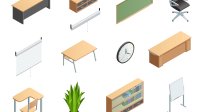3 Unused Teaching Tools: The Furniture, Floors, and Walls
Change your classroom environment and you can change your students’ behavior.
Your content has been saved!
Go to My Saved Content.I was nervous about how the ninth-grade students would react. All the tables were either against the walls or used to create the sides of a tour bus. The chairs that normally surrounded the tables were set in rows facing the projector screen as if they were looking out the window while seated on a bus. My concern was that with the chairs so close together—and no separating tables—the students would lose focus and want to talk, not listening to the tour guides as they presented on Spanish speaking cities, markets, museums, and zoos.
The students had helped to decorate the room, and they knew exactly what was going to happen. I wanted to give the students an opportunity to use authentic language in a realistic situation, and I used the tables, walls, and chairs to create that learning environment.
One of my mentors often said, “You can’t change people, but you can change their environment, and that will make the change happen." This saying can also apply in the classroom. You can change the environment to promote a desired behavior.
Some of the least used tools a teacher has to create optimal learning environments are the furniture, floors, and walls in the classroom. Taking these three underused teaching resources into account will help teachers to better engage the bodies and minds of their students.
Mash-Ups With Desks
The first underutilized spaces are the desks, chairs, and other furniture in the classroom. The set-up of my tour bus classroom was not the traditional straight rows facing forward, nor was it the collaborative grouping of four to a table I normally use. I had changed the arrangement of the desks because I had a particular purpose that changing the seats would facilitate: Straight rows lend themselves to giving the teacher more control over student behavior (reducing talking). They also help students to focus on the side of the room they are facing. When the teacher (or students) are presenting, this is ideal.
Back-to-back, side-by-side, circles, triangles, squares, and multiple other desk combinations can promote different behaviors. If trained correctly—within a lesson—students can quickly move their seats as necessary to accommodate the learning needs without causing disruptions. Here are five ways you can organize desks to promote specific outcomes:
- Debates: Split the class and put the desks on opposite sides facing each other.
- Jigsaw (where your students move around, teaching each other): Set up stations in the corners of the room.
- Paired work: Desks can be face-to-face or you can do double pairs—four to a group.
- Socratic Seminars: Create an inner and outer circle with your desks.
- Performances: Position all the desks on the perimeter of the class facing inward.
How About the Floor?
In early elementary, teachers place sitting carpets to gather students for storytelling. When my students perform the 10-second practice vocabulary quizzes, I have them stand in two lines, face-to-face with a partner. They quickly review the vocabulary, and when I call out, cambien! (switch in Spanish), one partner moves down to the next student and they have 10 seconds to teach their new partner their vocabulary words.
Activities like Simon Says, Do as I’m Doing, Verb Basketball, Conjugation Relay Races, Head Shoulder’s, Knees, and Toes, and dancing the Macarena all require floor space in order for the students to engage their bodies and brains.
I observed a math teacher place tape on her floor to represent graph paper, and the students had to physically graph the equation in groups. I have seen students use the floor for storyboarding, experimentation, and data gathering. So, go for it—move that furniture out of the way and help your students become totally engaged.
Walls That Talk
The wall spaces are just as changeable as the furniture and should match the learning activity. Word Walls are one way to make this happen. Typically, Word Walls are located on one section of the classroom wall. Depending on what is being studied, the words are changed periodically. Because I am a firm believer in total physical response learning, I spread my word wall all across the room. Additionally, I used non-verbal clues, such as pictures and drawings to represent words and phrases for the unit we're studying. I ask my students to point to, stand under, or touch the picture represented by the words I speak.
I can imagine a geometry teacher placing various geometric structures around the room and asking student to point to the rhombus, parallelogram, or stand under the isosceles triangle. An algebra or chemistry teacher could use formulas. In English, types of writing—expository, persuasive, descriptive, and narrative—could be displayed on the walls. In social studies, you could have illustrations of events. It only takes a few minutes to have all of the students participate in recall-learned information, and you can do it every day.
In my tour bus classroom makeover, the students walked in with ooh’s and aah’s and, surprisingly enough, sat down with little fanfare and began the warm-up writing assignment. Students were prepared when I called the first tour guide to give her presentation.
Effective use of the furniture, floors, and walls will further motivate students to learn through active participation and high engagement. Please share your creative use of classroom spaces in the comments section below.
